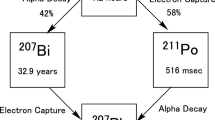Abstract.
The purpose of this study was to investigate the relative influence of scatter, attenuation, depth-dependent collimator response and finite spatial resolution upon the image characteristics in cardiac single-photon emission tomography (SPET). An acquisition of an anthropomorphic cardiac phantom was performed together with corresponding SPET Monte Carlo simulations. The cardiac phantom and the Monte Carlo simulations were designed so that the effect of scatter, attenuation, depth-dependent collimator response and finite spatial resolution could be studied individually and in combination. The impact of each physical effect and of combinations of effects was studied in terms of absolute and relative quantitative accuracy, spatial resolution and signal-to-noise ratio (SNR) in the resulting images. No corrections for these effects were assessed. Results obtained from Monte Carlo simulations and real acquisitions were in excellent agreement. Attenuation introduced about 90% activity underestimation in a 10-mm-thick left ventricle wall while finite spatial resolution alone introduced about 30% activity underestimation. Scatter had a negligible impact on quantitative accuracy in the recontructed slices when attenuation was present. Neither bull’s eye map homogeneity nor contrast between a hot and a cold region were affected by depth-dependent collimator response or finite spatial resolution. Bull’s eye map homogeneity was severely affected by attenuation but not by scatter. Attenuation and scatter reduced contrast by about 20% each. Both attenuation and scatter increased the full-width at half-maximum (FWHM) characterizing the spatial resolution of the imaging system by ≈1 mm each but the main effect responsible for the observed 11-mm FWHM spatial resolution was the depth-dependent collimator response. SNR was reduced by a factor of ≈2.5 because of attenuation, while scattered counts increased SNR by ≈10%. In conclusion, the quantification of the relative influence of the different physical effects showed that attenuation is definitely the major phenomenon affecting cardiac SPET imaging accuracy, but that finite spatial resolution, scatter and depth-dependent collimator response also contribute significantly to the errors in absolute and relative quantitation and to the poor spatial resolution.
Similar content being viewed by others
Author information
Authors and Affiliations
Additional information
Received 12 November 1998 and in revised form 21 January 1999
Rights and permissions
About this article
Cite this article
El Fakhri, G., Buvat, I., Pélégrini, M. et al. Respective roles of scatter, attenuation, depth-dependent collimator response and finite spatial resolution in cardiac single-photon emission tomography quantitation: a Monte Carlo study. Eur J Nucl Med 26, 437–446 (1999). https://doi.org/10.1007/s002590050409
Issue Date:
DOI: https://doi.org/10.1007/s002590050409




